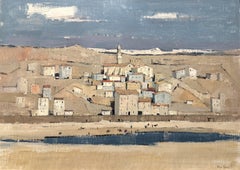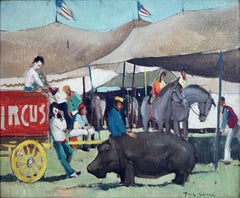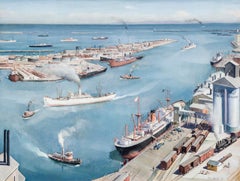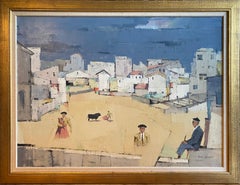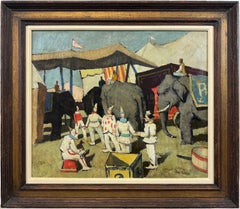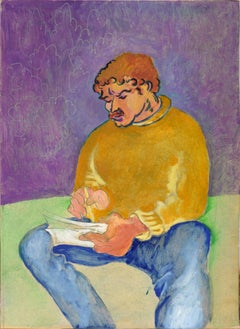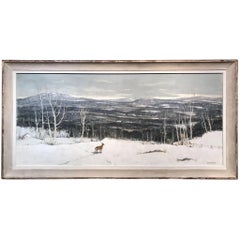Paul Sample Paintings
to
4
2
1
Overall Width
to
Overall Height
to
7
1
1
1
3
1
7
3
2
2
2
2
2
1
1
1
1
1
1
1
1
1
1
1
1
1
1
7
5
5
5
2
9
781
713
712
689
5
7
Artist: Paul Sample
Vermont Farm
By Paul Sample
Located in Milford, NH
A fine impressionist landscape of a Vermont farm by American artist Paul Starrett Sample (1896-1974). Sample was born in Louisville, Kentucky and went to school at Dartmouth College,...
Category
Mid-20th Century American Impressionist Paul Sample Paintings
Materials
Canvas, Acrylic
$9,800
"Spanish Village" Paul Sample, Mid 20th Century European Scene, Pastel Colors
By Paul Sample
Located in New York, NY
Paul Sample
Spanish Village, 1958
Signed lower right; titled on artist label affixed to the reverse
Acrylic on Masonite
23 1/4 x 33 inches
Provenace
Milch Galleries, New York
Privat...
Category
1950s Realist Paul Sample Paintings
Materials
Masonite, Oil
"Hippo" Paul Sample, Regionalist, Atmospheric Circus Performers and Animal Scene
By Paul Sample
Located in New York, NY
Paul Sample
Hippo
Signed lower right
Oil on canvas
16 x 20 inches
Provenance
Chidsey Collection
Private Collection (acquired from the above in 1980)
Sample's attempt to impose a T...
Category
1930s Realist Paul Sample Paintings
Materials
Canvas, Oil
San Pedro Harbor
By Paul Sample
Located in New York, NY
It is infrequent, to say the least, that a diagnosis of tuberculosis proves fortuitous, but that was the event, in 1921, that set Paul Starrett Sample on the road to becoming a professional artist. (The best source for an overview of Sample’s life and oeuvre remains Paul Sample: Painter of the American Scene, exhib. cat., [Hanover, New Hampshire: Hood Museum of Art, 1988] with a detailed and definitive chronology by Sample scholar, Paula F. Glick, and an essay by Robert L. McGrath. It is the source for this essay unless otherwise indicated.) Sample, born in Louisville, Kentucky, in 1896 to a construction engineer and his wife, spent his childhood moving with his family to the various locations that his father’s work took them. By 1911, the family had landed in Glencoe, Illinois, settling long enough for Paul to graduate from New Trier High School in 1916. Sample enrolled at Dartmouth College, in Hanover, New Hampshire, where his interests were anything but academic. His enthusiasms included the football and basketball teams, boxing, pledging at a fraternity, and learning to play the saxophone. After the United States entered World War I, Sample, to his family’s dismay, signed on for the Naval Reserve, leading directly to a hiatus from Dartmouth. In 1918 and 1919, Sample served in the U.S. Merchant Marine where he earned a third mate’s license and seriously contemplated life as a sailor. Acceding to parental pressure, he returned to Dartmouth, graduating in 1921. Sample’s undergraduate life revolved around sports and a jazz band he formed with his brother, Donald, two years younger and also a Dartmouth student. In November 1933, Sample summarized his life in a letter he wrote introducing himself to Frederick Newlin Price, founder of Ferargil Galleries, who would become his New York art dealer. The artist characterized his undergraduate years as spent “wasting my time intensively.” He told Price that that “I took an art appreciation course and slept thru it every day” (Ferargil Galleries Records, circa 1900–63, Archives of American Art, Smithsonian Institution, available on line).
In 1920, Donald Sample contracted tuberculosis. He went for treatment to the world-famous Trudeau Sanitorium at Saranac Lake, in New York State’s Adirondack Mountains for the prescribed regimen of rest, healthful food, and fresh air. Visiting his brother in 1921, Paul also contracted the disease. Tuberculosis is highly contagious, and had no certain cure before the development of streptomycin in 1946. Even for patients who appeared to have recovered, there was a significant rate of recurrence. Thus, in his letter to Price, Sample avoided the stigma conjured by naming the disease, but wrote “I had a relapse with a bad lung and spent the next four years hospitalized in Saranac Lake.” The stringent physical restrictions imposed by adherence to “the cure” required Sample to cultivate an alternate set of interests. He read voraciously and, at the suggestion of his physician, contacted the husband of a fellow patient for instruction in art. That artist, then living in Saranac, was Jonas Lie (1880–1940), a prominent Norwegian-American painter and an associate academician at the National Academy of Design. Lie had gained renown for his dramatic 1913 series of paintings documenting the construction of the Panama Canal (The Metropolitan Museum of Art, New York; United States Military Academy, West Point, New York). Primarily a landscape artist, Lie had a particular affinity for scenes with water. His paintings, impressionistic, atmospheric, and brushy, never strayed from a realistic rendering of his subject. Sample regarded Lie as a mentor and retained a lifelong reverence for his teacher. Sample’s early paintings very much reflect Lie’s influence.
`
In 1925, “cured,” Sample left Saranac Lake for what proved to be a brief stay in New York City, where his veteran’s benefits financed a commercial art course. The family, however, had moved to California, in the futile hope that the climate would benefit Donald. Sample joined them and after Donald’s death, remained in California, taking classes at the Otis Art Institute in Los Angeles. In Sample’s account to Price, “I couldn’t stomach the practice of painting a lot of High Sierras and desert flowers which seemed to be the only kind of pictures that were sold here so I got a job teaching drawing and painting at the art school of the University of Southern California.” Initially hired as a part-time instructor, Sample progressed to full-time status and ultimately, by the mid-1930s, to the post of Chairman of the Fine Art Department. Sample, however, did not want to wind up as a professor. “Teaching is all right in small doses,” he wrote, “but I have a horror of drifting into being a college professor and nothing more.” At the same time as he taught, Sample began to exhibit his work in a variety of venues at first locally, then nationally. Though he confessed himself “a terrible salesman,” and though occupied with continued learning and teaching, Sample was nonetheless, ambitious. In 1927, he wrote in his diary, “I am eventually going to be a painter and a damned good one. And what is more, I am going to make money at it” (as quoted by Glick, p. 15). In 1928, Sample felt sufficiently solvent to marry his long-time love, Sylvia Howland, who had also been a patient at Saranac Lake. The Howland family were rooted New Englanders and in summertime the Samples regularly traveled East for family reunion vacations.
While the 1930s brought serious hardship to many artists, for Paul Sample it was a decade of success. Buttressed by the financial safety net of his teacher’s salary, he painted realist depictions of the American scene. While his work addressed depression-era conditions with a sympathetic eye, Sample avoided the anger and tinge of bitterness that characterized much contemporary realist art. Beginning in 1930, Sample began to exhibit regularly in juried exhibitions at important national venues, garnering prizes along the way. In 1930, Inner Harbor won an honorable mention in the Annual Exhibition of the Art Institute of Chicago. That same year Sample was also represented in a show at the Albright-Knox Gallery in Buffalo and at the Biennial Exhibition of the Corcoran Gallery of Art, Washington, D.C. In 1931, Dairy Ranch won the second Hallgarten Prize at the Annual Exhibition of the National Academy of Design, in New York. Sample also made his first appearances at the Carnegie Institute, Pittsburgh, and The Pennsylvania Academy of the Fine Arts, Philadelphia. In 1936, Miner’s Resting won the Temple Gold Medal at the Pennsylvania Academy’s Annual Exhibition. Always interested in watercolor, in 1936, Sample began to send works on paper to exhibitions at the Whitney Museum, New York.
While participating in juried exhibitions, Sample also cultivated commercial possibilities. His first New York art dealer was the prestigious Macbeth Gallery in New York, which included his work in a November 1931 exhibition. In 1934, Sample joined the Ferargil Galleries in New York, after Fred Price arranged the sale of Sample’s Church Supper to the Michele and Donald D’Amour Museum of Fine Arts in Springfield, Massachusetts. In 1937, The Metropolitan Museum of Art purchased Sample’s Janitor’s Holiday from the annual exhibition of the National Academy of Design, a notable honor.
As prestigious as this exhibition schedule may have been, by far Sample’s most visible presence in the 1930s and 1940s was the result of his relationship with Henry Luce’s burgeoning publishing empire, Time, Inc. Sample’s first contribution to a Luce publication appears to have been another San Pedro...
Category
20th Century American Modern Paul Sample Paintings
Materials
Canvas, Oil
Memories of an Old Man
By Paul Sample
Located in Los Angeles, CA
An Acrylic on canvas titled " Memories of an Old Man"
C. 1960's, signed lower right.
Provenance: Milch Galleries NY, label affixed.
Canvas measures 28 x 36 inches.
Framed size is app...
Category
1960s American Modern Paul Sample Paintings
Materials
Acrylic
“Circus Yard” American Regionalist, Elephants, Tents, Performers, Clowns, Oil
By Paul Sample
Located in Yardley, PA
“Circus Yard” by Paul Starrett Sample (American, 1896-1974).
A vibrant circus scene by the noted American regionalist, Paul Starrett Sample. This work captures the lively bustle beh...
Category
Mid-20th Century American Realist Paul Sample Paintings
Materials
Canvas, Oil
The Wood Decoy oil painting by Paul Sample
By Paul Sample
Located in Hudson, NY
Signed "Paul Sample" lower right; titled and signed verso: "The Wood Decoy" & "Paul Sample" in pencil in the artist's hand.
Paul Sample was an acclaimed Ne...
Category
Mid-20th Century American Modern Paul Sample Paintings
Materials
Canvas, Oil
Related Items
Artist Self Portrait in an Orange Sweater - Fauvist Portrait
By Don Klopfer
Located in Soquel, CA
Boldly colored portrait of a the artist sketching by California artist Richard "Don" Klopfer (1920-2009). The seated figure is juxtaposed to a fun and vibrant two-toned background of...
Category
Late 20th Century American Modern Paul Sample Paintings
Materials
Masonite, Acrylic
$950
H 14 in W 10 in D 0.13 in
R.E.M. - Murmur (Grammy, Album Art, Iconic, Rock and Roll, Pop, Legendary)
By Kerry Smith
Located in Kansas City, MO
Kerry Smith
R.E.M. - Murmur
Mixed Media on Crescent board
Year: 2022
Size: 21x20in
Signed, dated by hand
COA provided
Ref.: 924802-1633
*Black frame with a mirror-gloss finish avail...
Category
2010s American Modern Paul Sample Paintings
Materials
Mixed Media, Acrylic, Gouache, Board
$888 Sale Price
25% Off
H 21 in W 22 in D 1 in
No one but the bees
Located in Zofingen, AG
Bright flowers, juicy fruits and of course the helpers of our garden: hardworking bees. They also love the juice of ripe pears. Being behind a canvas woven from my thoughts and emoti...
Category
2010s American Realist Paul Sample Paintings
Materials
Canvas, Oil
1940s Mexican City Scene by Famed Artist Francis Chapin, San Miguel de Allende
By Francis Chapin
Located in Chicago, IL
A charming, vibrant, early Mexican city street scene by famed Chicago Modern artist Francis Chapin (Am. 1899-1965). Depicting a bustling, picturesque view of the shaded, arched arcade of the Portal de Guadalupe in the historic city of San Miguel de Allende, the painting is oil on canvas and dates circa 1940. The towering pink spire of the majestic church, the Parroquia de San Miguel Arcángel...
Category
1940s American Modern Paul Sample Paintings
Materials
Oil, Canvas
$1,200
H 21 in W 26 in D 2 in
Antique American Oil Painting Framed Horse Race Elizabeth Bell Arabian Dappled
Located in Buffalo, NY
Elizabeth Bell’s Dappled Elegance is a masterfully rendered oil painting celebrating the grace and stature of an Arabian or American Saddlebred horse in motion. The artist captures t...
Category
1930s American Realist Paul Sample Paintings
Materials
Canvas, Oil
City at Night (Cityscape)
By Abram Tromka
Located in Wilton Manors, FL
Abram Tromka (1895-1964)
City at Night, ca. 1940.
Oil on canvas, 16 x 20 inches; 20 x 24 inches in antique oak frame. Signed lower right.
Frame is of the period, but probably not ...
Category
1930s American Modern Paul Sample Paintings
Materials
Canvas, Oil
Golfer Swinging, Vintage 7 Up Ad "Get Real Action" in Green and Yellow - Golf
By Bob Peak
Located in Miami, FL
This strobe-like dynamic composition with bright and bold colors reflects the energetic taste of the 7 Up brand. It lies somewhere between abstraction and figuration. Peaks' use of b...
Category
1960s American Modern Paul Sample Paintings
Materials
Acrylic, Illustration Board
$15,000
H 23.25 in W 21.25 in
"End of the Line" - Oil on Canvas Nocturne Landscape With Desert Cabin
By Mark Harrison
Located in Denver, CO
Mark Harrison’s 2024 oil painting "End of the Line" is a hauntingly atmospheric depiction of a solitary desert cabin illuminated against the vast quiet of the American Southwest. Ren...
Category
21st Century and Contemporary Realist Paul Sample Paintings
Materials
Oil, Canvas
$2,750
H 15.75 in W 39.37 in
Long Shadows Beach Walk
By Kathleen Keifer
Located in Los Angeles, CA
Kathleen Keifer's original artworks represent one of the most significant expressions of New California Realism. Keifer brings a fresh perspective to her colorful scenes of everyday ...
Category
21st Century and Contemporary American Impressionist Paul Sample Paintings
Materials
Canvas, Acrylic
"Fallow Fields" Oil painting
By Lani Vlaanderen
Located in Denver, CO
Lani Vlaanderen's (US based) "Fallow Fields" is an oil painting that depicts two working horses plowing a field with dust billowing around them.
Bio/artist statement:
Living in the mountains near Rocky Mountain National Park Lani is never lacking something inspiring to paint, be it a grand sunrise on Long's Peak or a small sparrow perched on a pine branch. All fill her with the desire to put paint to canvas. Her goal is not to replicate what she sees, but to express her emotional response from the source of inspiration visually in paint and convey it to the world. She wants to communicate the awe she feels when in the natural world and the joy she experiences from seeing even the seemingly most insignificant moment in time that will never come again. She strives to convey her belief that all things, all beings, all life and non-life, share equal significance and are essential to the whole.
"I began my art quest by taking a few classes at Rocky Mountain College of Art and Design, then enrolled in Kim English's class at the Art Student's Leaque of Denver. After four years with Kim and functioning as his class monitor, I had the opportunity to participate in a painting group with Richard Schmid in Loveland Colorado. I painted there with him for six years. I have taken workshops from such masters as David Leffel, Sherrie McGraw...
Category
2010s American Realist Paul Sample Paintings
Materials
Oil
Palm Springs City Hall - Original Blue Landscape California Desert Artwork
By Kathleen Keifer
Located in Los Angeles, CA
Kathleen Keifer's original artworks represent one of the most significant expressions of New California Realism. Keifer brings a fresh perspective to her colorful scenes of everyday ...
Category
2010s American Impressionist Paul Sample Paintings
Materials
Acrylic, Canvas
Pink Sunset in Winter Birch Forest Giant Landscape early 20 Сentury Oil Painting
Located in Stockholm, SE
An impressive painting in size and execution, a frosty winter day in a birch grove with a small pond. The orange-yellow sunset reflected on the surface of the pond creates the illusion of bizarre reflections. The frosty haze that has enveloped the forest intertwines with the approaching twilight, enhancing the sense of depth and atmosphere. On the right we see a traveler returning from the forest with an armful of brushwood on his back. In the distance a small flock of birds flies in, alarmed by something, bringing a sense of movement to this scene. The contrast of bright and cold shades creates an atmosphere of calm and silence...
Category
Early 20th Century Realist Paul Sample Paintings
Materials
Canvas, Wood, Oil
$590
H 35 in W 52.8 in D 1.5 in
Previously Available Items
Horse & Rider
By Paul Sample
Located in Milford, NH
A fine impressionist watercolor painting of a horse and rider by American artist Paul Sample (1896-1974). Sample was born in Louisville, Kentucky and went to school at Dartmouth Coll...
Category
Mid-20th Century American Impressionist Paul Sample Paintings
Materials
Paper, Watercolor
View of Verney Farm, Bennington NH
By Paul Sample
Located in Milford, NH
This exceptional winter landscape was painted by American artist Paul Starrett Sample (1896-1974). Sample was born in Louisville, Kentucky and wen...
Category
Mid-20th Century Realist Paul Sample Paintings
Materials
Canvas, Oil
Stockton
By Paul Sample
Located in Palm Desert, CA
In this painting the viewer is given a birds-eye view of the inland port of Stockton, California. The straightforward realism of the piece contrasts with the more lyrical paintings o...
Category
20th Century Modern Paul Sample Paintings
Materials
Oil
House in the country
By Paul Sample
Located in Los Angeles, CA
This is a fine example of Paul Sample's work.
It is oil on Masonite, excellent condition, framed.
Paul Sample, N.A. (1896-1974) Born: Louisville, KY; Studied: Dartmouth Colleg...
Category
1950s Modern Paul Sample Paintings
Materials
Masonite, Oil
Paul Sample paintings for sale on 1stDibs.
Find a wide variety of authentic Paul Sample paintings available for sale on 1stDibs. If you’re browsing the collection of paintings to introduce a pop of color in a neutral corner of your living room or bedroom, you can find work that includes elements of blue and other colors. You can also browse by medium to find art by Paul Sample in oil paint, paint, canvas and more. Much of the original work by this artist or collective was created during the 20th century and is mostly associated with the modern style. Not every interior allows for large Paul Sample paintings, so small editions measuring 10 inches across are available. Customers who are interested in this artist might also find the work of Everett Shinn, William Harnden, and Alfred Wands. Paul Sample paintings prices can differ depending upon medium, time period and other attributes. On 1stDibs, the price for these items starts at $8,500 and tops out at $275,000, while the average work can sell for $11,900.
